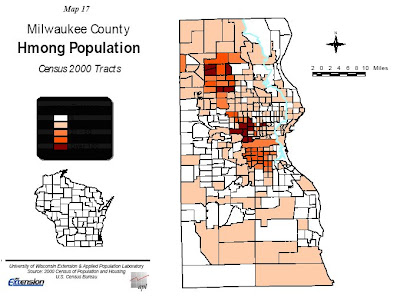Friday, May 9, 2008
Hmong First Baptist Church: Focus on Milwaukee Youth
Hmong First Baptist Youth, the younger years
Found Video
"Hmong rally for peace and justice. Roughly 400 Hmong people came to support. Those who knew and didn't know the victim came to stand by his side. Why? Because no matter what relation if any, they came to support their people. Police brutality is a crime. Something interesting at end of clip. Add your comments/suggestions."
Thursday, May 8, 2008
Hmong Demographics [Part 1]
http://www.ssc.wisc.edu/poplab/reports/HmongChartbook.pdf
Overall Totals:
• Wisconsin's Hmong population grew from 16,373 in 1990 to 33,791 persons in 2000, a 106%
increase. In contrast, the largest racial group in Wisconsin, whites, increased by only 4.8%.
• The Hmong population in Wisconsin was 0.63% of the state's total population in 2000, compared to 0.33% in 1990.
• Hmong persons represent 32.9% of Wisconsin’s total Asian population of 102,823 persons. This is more than double the proportion of each of the next two largest Asian subgroups in Wisconsin:
Asian Indian and Chinese.
The Hmong population in Wisconsin is concentrated in several regions:
• 23.3% of Wisconsin's total Hmong population resides in Milwaukee County; 13.2% live in
Marathon County.
• Three counties in Wisconsin have Hmong populations that exceed 2% of the total county
population: Marathon (3.5%), Sheboygan (2.4%), and La Crosse (2.1%).
• Seven counties in Wisconsin have more than 2,000 persons of Hmong origin: Milwaukee (7,883), Marathon (4,453), Brown (2,957), Sheboygan (2,706), Outagamie (2,504), La Crosse (2,282), and Dane (2,235).
• Dane County’s Hmong population increased by 298% between 1990 and 2000, from 561 to 2,235 persons, the largest increase among the 10 Wisconsin counties with more than 500 Hmong
residents in 1990. Hmong in Wisconsin are younger than the total population and live in large
families with married couples and children.
• 57.1% of Wisconsin's Hmong population is under age 18 and in all, over 23,000 Hmong (more
than two-thirds of the total) are under age 24.
• More than 98% of Wisconsin’s Hmong population live in family households; and almost 70% of
these family households are headed by married couples with children.
• The average family size for Hmong in Wisconsin is 6.4 persons, more than double the average
family size for the total population (3.1).
● Births to teens are much more common among Hmong females than among the average Wisconsin female. In 2001, 13% of all Hmong births occurred to mothers 18-19 years old, while amongst the total population only 7% did. Another 10% of Hmong births occurred to mothers 15-17 years old.
Monday, May 5, 2008
Thursday, April 24, 2008
Photo Essay Artist Statement
The experience of putting together my photographical essay was a very interesting one. When I arrived to shoot for this project, I didn’t really have an idea of what I wanted to focus on. Then it became clear to me that even though we had a tour of the
I had a long conversation with James, a worker at the
The camera, as an instrument of investigation, made it easy to capture the pleasant atmosphere of the Center. It allowed me to document the feelings of accomplishment that the Center has so far in restoring the community.
My essay is put together in the same chronological order as my visit. I chose to present my essay as a combination of a story and strict documentation. I describe the context of the photographs in regards to what James was telling me about the specific objects documented in them. The captions that I included with the photographs have a specific connection to my conversation with James. In this way, I also document what he told me about HomeSource in a direct, but personal level.










